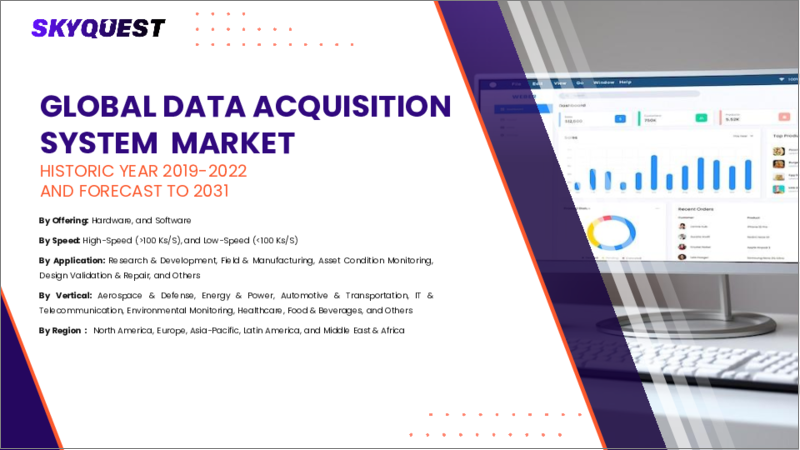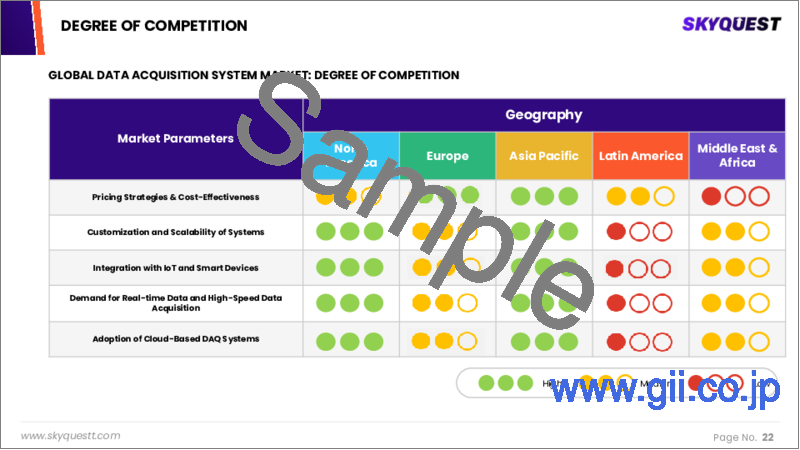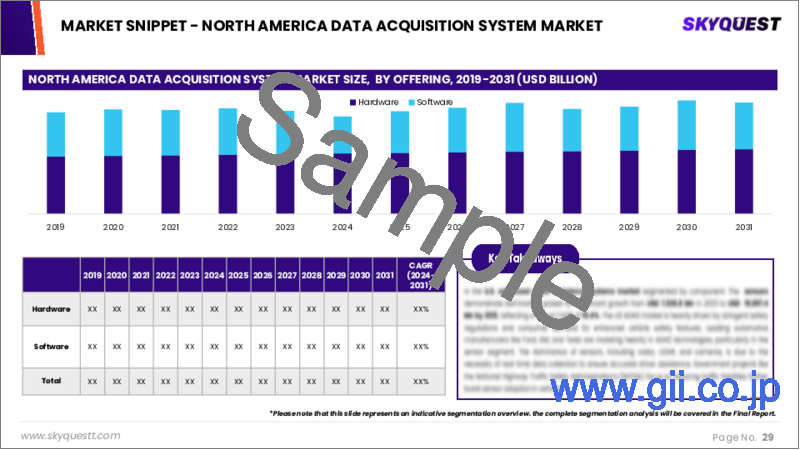|
|
市場調査レポート
商品コード
1569466
データ収集(DAQ)システムの市場規模、シェア、成長分析:提供別、速度別、用途別、業種別、地域別 - 産業予測、2024-2031年Data Acquisition System Market Size, Share, Growth Analysis, By Offering, By Speed (High-Speed, Low-Speed ), By Application, By Vertical, By Region - Industry Forecast 2024-2031 |
||||||
|
|||||||
| データ収集(DAQ)システムの市場規模、シェア、成長分析:提供別、速度別、用途別、業種別、地域別 - 産業予測、2024-2031年 |
|
出版日: 2024年10月13日
発行: SkyQuest
ページ情報: 英文 197 Pages
納期: 3~5営業日
|
全表示
- 概要
- 目次
データ収集(DAQ)システムの世界市場規模は、2022年に19億6,000万米ドルと評価され、2023年の20億7,000万米ドルから2031年には32億1,000万米ドルに達し、予測期間中(2024-2031年)のCAGRで5.63%の成長が予測されています。
データ主導の時代に進むにつれ、データ収集(DAQ)システムの重要性はますます高まっており、その背景には効果的なデータ監視・管理に対するさまざまな産業分野での需要の高まりがあります。インダストリー4.0原則の継続的な統合が産業オートメーションを推進し、その結果、データ収集(DAQ)システムを専門とする企業に有利な機会が生まれています。複数のアプリケーションにおける革新的なモノのインターネット(IoT)デバイスの普及は、この成長の可能性をさらに高め、システムプロバイダーが開発すべき新たな道を提供しています。しかし、将来性があるように見える一方で、これらのシステムの統合と展開に関連する複雑な課題は、長期的には販売の妨げになる可能性があります。まとめると、データ収集(DAQ)システム市場は、データ需要の増大と自動化の動向によって大きく成長する可能性があるが、利害関係者がこうした新たな機会を十分に活用するには、統合のハードルを乗り越えなければならないです。
目次
イントロダクション
- 調査の目的
- 定義
- 市場範囲
調査手法
- 情報調達
- 二次データソースと一次データソース
- 市場規模予測
- 市場の想定と制限
エグゼクティブサマリー
- 市場概要見通し
- 供給需要動向分析
- セグメント別機会分析
市場力学と見通し
- 市場力学
- 促進要因
- 機会
- 抑制要因
- 課題
- ポーターの分析
主な市場の考察
- 主な成功要因
- 競合の程度
- 主な投資機会
- 市場のエコシステム
- バリューチェーン分析
- サプライチェーン分析
- ケーススタディ分析
- 特許分析
- 貿易分析
- 技術分析
- 規制情勢
データ収集(DAQ)システム市場:提供別
- 市場概要
- ハードウェア
- ソフトウェア
データ収集(DAQ)システム市場:速度別
- 市場概要
- 高速(100 KS/S 超)
- 低速(100 KS/S 未満)
データ収集(DAQ)システム市場:用途別
- 市場概要
- 研究開発
- フィールド
- 製造
データ収集(DAQ)システム市場:業種別
- 市場概要
- 航空宇宙・防衛
- エネルギー・電力
- 自動車・輸送
- 無線通信・インフラ
- 環境モニタリング
- ヘルスケア
- 食品・飲料
- その他
データ収集(DAQ)システム市場規模:地域別
- 市場概要
- 北米
- 米国
- カナダ
- 欧州
- ドイツ
- スペイン
- フランス
- 英国
- イタリア
- その他欧州地域
- アジア太平洋地域
- 中国
- インド
- 日本
- 韓国
- その他アジア太平洋地域
- ラテンアメリカ
- ブラジル
- その他ラテンアメリカ地域
- 中東・アフリカ(MEA)
- GCC諸国
- 南アフリカ
- その他中東・アフリカ地域
競合情勢
- 上位5社の比較
- 主要企業の市場ポジショニング(2023年)
- 主な市場企業が採用した戦略
- 市場における最近の活動
- 主要企業の市場シェア(2023年)
主要企業プロファイル
- Keysight Technologies
- Spectris
- Siemens AG
- Adlink Technology
- Ametek
- Dewesoft
- Teledyne Technologies
- Yokogawa Electric
- Astronova
- Campbell Scienitifc
- Curtiss-Wright
- Dewetron
- Data Forth
- Emerson Electric
- Gantner Instruments
- General Electric
- Graphtec
- Hioki
- Honeywell
- IMC Test & Measurement
- Kistler
- MTS Systems
- Rockwell Automation
- Schneider Electric
- Sefram Instruments
Global Data Acquisition System Market size was valued at USD 1.96 billion in 2022 and is poised to grow from USD 2.07 billion in 2023 to USD 3.21 billion by 2031, growing at a CAGR of 5.63% during the forecast period (2024-2031).
As we advance into a data-driven era, the significance of data acquisition systems is becoming increasingly paramount, fueled by the rising demand across various industry sectors for effective data monitoring and management. The ongoing integration of Industry 4.0 principles is propelling industrial automation, which in turn is creating lucrative opportunities for companies specializing in data acquisition systems. The proliferation of innovative Internet of Things (IoT) devices across multiple applications further enhances this growth potential, offering new avenues for system providers to explore. However, while prospects appear promising, the intricate complexities associated with the integration and deployment of these systems pose substantial challenges that could hinder sales in the long run. In summary, the market for data acquisition systems is poised for significant growth driven by increasing data demands and automation trends, yet stakeholders must navigate integration hurdles to fully capitalize on these emerging opportunities.
Top-down and bottom-up approaches were used to estimate and validate the size of the global data acquisition system market and to estimate the size of various other dependent submarkets. The research methodology used to estimate the market size includes the following details: The key players in the market were identified through secondary research, and their market shares in the respective regions were determined through primary and secondary research. This entire procedure includes the study of the annual and financial reports of the top market players and extensive interviews for key insights from industry leaders such as CEOs, VPs, directors, and marketing executives. All percentage shares split, and breakdowns were determined using secondary sources and verified through Primary sources. All possible parameters that affect the markets covered in this research study have been accounted for, viewed in extensive detail, verified through primary research, and analyzed to get the final quantitative and qualitative data.
global data acquisition system Market Segmental Analysis
Global Data Acquisition System Market is segmented by Offering, Speed, Application, Vertical, and Region. Based on Offering, the market is segmented into Hardware (External Chassis & Modules, Plug-In Analog I/O Boards), Software (Bundled, Third-Party). Based on Speed, the market is segmented into High-Speed (>100 KS/S), Low-Speed (<100 KS/S). Based on Application, the market is segmented into R&D, Field, Manufacturing, Others. Based on Vertical, the market is segmented into Aerospace & Defense, Energy & Power, Automotive & Transportation, Wireless Communication & Infrastructure, Environmental Monitoring, Healthcare, Food & Beverages, Others. Based on region, the market is segmented into North America, Europe, Asia Pacific, Latin America and Middle East & Africa.
Driver of the global data acquisition system Market
The increasing trend of automation across various industries globally stands as a significant market driver for the global data acquisition system market. As organizations strive to enhance operational efficiency and optimize productivity, they are increasingly integrating sophisticated data acquisition systems to facilitate real-time monitoring, accurate data collection, and streamlined analytics. This shift not only helps in minimizing human error but also enables businesses to harness valuable insights from their processes, leading to improved decision-making and profitability. Consequently, the surge in demand for automation solutions is expected to bolster sales and innovation within the data acquisition systems sector, creating a robust growth trajectory.
Restraints in the global data acquisition system Market
The integration of data acquisition systems with existing infrastructures and technologies presents a significant market restraint, as it often involves substantial capital and labor investments. Organizations may face challenges in procuring the necessary skilled technicians capable of executing these complex integrations and deployments. This requirement not only escalates costs but also potentially results in project delays, thus hindering the overall growth and adoption of data acquisition systems. Consequently, businesses may hesitate to invest in such systems, limiting market expansion and innovation in this sector over the long term, ultimately slowing down the progression and evolution of data acquisition technologies.
Market Trends of the global data acquisition system Market
The global data acquisition system market is witnessing a robust trend towards the adoption of machine learning and artificial intelligence, reshaping how data is collected, analyzed, and utilized. Providers are increasingly integrating these advanced technologies to enhance decision-making capabilities, ensuring greater accuracy and reducing human errors in data handling. This shift not only streamlines the data acquisition process but also facilitates automation, allowing companies to operate more efficiently and maximize profits. As industries recognize the critical role of data intelligence, the demand for sophisticated and automated data acquisition systems is expected to surge, driving significant growth in this market segment.
Table of Contents
Introduction
- Objectives of the Study
- Definitions
- Market Scope
Research Methodology
- Information Procurement
- Secondary & Primary Data Sources
- Market Size Estimation
- Market Assumptions & Limitations
Executive Summary
- Market Overview Outlook
- Supply Demand Trend Analysis
- Segmental Opportunity Analysis
Market Dynamics & Outlook
- Market Dynamics
- Drivers
- Opportunities
- Restraints
- Challenges
- Porters Analysis
- Competitive rivalry
- Threat of Substitute Products
- Bargaining Power of Buyers
- Threat of New Entrants
- Bargaining Power of Suppliers
Key Market Insights
- Key Success Factor
- Degree of Competition
- Top Investment Pockets
- Ecosystem of the Market
- Value Chain Analysis
- Supply Chain Analysis
- Case Study Analysis
- Patent Analysis
- Trade Analysis
- Technology Analysis
- Regulatory Landscape
Data Acquisition System Market, By Offering
- Market Overview
- Hardware
- External Chassis & Modules
- Plug-In Analog I/O Boards
- Software
- Bundled
- Third-Party
Data Acquisition System Market, By Speed
- Market Overview
- High-Speed (>100 KS/S)
- Low-Speed (<100 KS/S)
Data Acquisition System Market, By Application
- Market Overview
- R&D
- Field
- Manufacturing
Data Acquisition System Market, By Vertical
- Market Overview
- Aerospace & Defense
- Energy & Power
- Automotive & Transportation
- Wireless Communication & Infrastructure
- Environmental Monitoring
- Healthcare
- Food & Beverages
- Others
Data Acquisition System Market Size by Region
- Market Overview
- North America
- USA
- Canada
- Europe
- Germany
- Spain
- France
- UK
- Italy
- Rest of Europe
- Asia Pacific
- China
- India
- Japan
- South Korea
- Rest of Asia-Pacific
- Latin America
- Brazil
- Rest of Latin America
- Middle East & Africa (MEA)
- GCC Countries
- South Africa
- Rest of MEA
Competitive Landscape
- Top 5 Player Comparison
- Market Positioning of Key Players, 2023
- Strategies Adopted by Key Market Players
- Recent Activities in the Market
- Key Companies Market Share (%), 2023
Key Company Profiles
- Keysight Technologies
- Company Overview
- Business Segment Overview
- Financial Updates
- Key Developments
- Spectris
- Company Overview
- Business Segment Overview
- Financial Updates
- Key Developments
- Siemens AG
- Company Overview
- Business Segment Overview
- Financial Updates
- Key Developments
- Adlink Technology
- Company Overview
- Business Segment Overview
- Financial Updates
- Key Developments
- Ametek
- Company Overview
- Business Segment Overview
- Financial Updates
- Key Developments
- Dewesoft
- Company Overview
- Business Segment Overview
- Financial Updates
- Key Developments
- Teledyne Technologies
- Company Overview
- Business Segment Overview
- Financial Updates
- Key Developments
- Yokogawa Electric
- Company Overview
- Business Segment Overview
- Financial Updates
- Key Developments
- Astronova
- Company Overview
- Business Segment Overview
- Financial Updates
- Key Developments
- Campbell Scienitifc
- Company Overview
- Business Segment Overview
- Financial Updates
- Key Developments
- Curtiss-Wright
- Company Overview
- Business Segment Overview
- Financial Updates
- Key Developments
- Dewetron
- Company Overview
- Business Segment Overview
- Financial Updates
- Key Developments
- Data Forth
- Company Overview
- Business Segment Overview
- Financial Updates
- Key Developments
- Emerson Electric
- Company Overview
- Business Segment Overview
- Financial Updates
- Key Developments
- Gantner Instruments
- Company Overview
- Business Segment Overview
- Financial Updates
- Key Developments
- General Electric
- Company Overview
- Business Segment Overview
- Financial Updates
- Key Developments
- Graphtec
- Company Overview
- Business Segment Overview
- Financial Updates
- Key Developments
- Hioki
- Company Overview
- Business Segment Overview
- Financial Updates
- Key Developments
- Honeywell
- Company Overview
- Business Segment Overview
- Financial Updates
- Key Developments
- IMC Test & Measurement
- Company Overview
- Business Segment Overview
- Financial Updates
- Key Developments
- Kistler
- Company Overview
- Business Segment Overview
- Financial Updates
- Key Developments
- MTS Systems
- Company Overview
- Business Segment Overview
- Financial Updates
- Key Developments
- Rockwell Automation
- Company Overview
- Business Segment Overview
- Financial Updates
- Key Developments
- Schneider Electric
- Company Overview
- Business Segment Overview
- Financial Updates
- Key Developments
- Sefram Instruments
- Company Overview
- Business Segment Overview
- Financial Updates
- Key Developments






